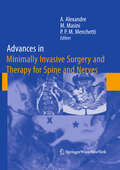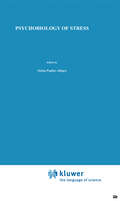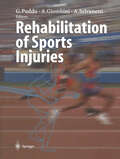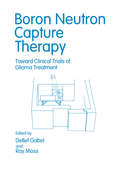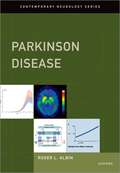- Table View
- List View
Medicine, Emotion and Disease, 1700-1950
by Fay Bound AlbertiUsing interdisciplinary techniques and original research findings, this volume explores the shift from humoral to nervous interpretations of emotion; the emotional nature of the medical professional-patient relationship; and the extent to which gender might influence the diagnosis, treatment and prognosis of pathological emotional conditions.
International Textbook of Diabetes Mellitus, 2 Volume Set
by George Alberti P. Zimmet E. Ferrannini R. A. DeFronzoThe International Textbook of Diabetes Mellitus has been a successful, well-respected medical textbook for almost 20 years, over 3 editions. Encyclopaedic and international in scope, the textbook covers all aspects of diabetes ensuring a truly multidisciplinary and global approach. Sections covered include epidemiology, diagnosis, pathogenesis, management and complications of diabetes and public health issues worldwide. It incorporates a vast amount of new data regarding the scientific understanding and clinical management of this disease, with each new edition always reflecting the substantial advances in the field. Whereas other diabetes textbooks are primarily clinical with less focus on the basic science behind diabetes, ITDM's primary philosophy has always been to comprehensively cover the basic science of metabolism, linking this closely to the pathophysiology and clinical aspects of the disease. Edited by four world-famous diabetes specialists, the book is divided into 13 sections, each section edited by a section editor of major international prominence. As well as covering all aspects of diabetes, from epidemiology and pathophysiology to the management of the condition and the complications that arise, this fourth edition also includes two new sections on NAFLD, NASH and non-traditional associations with diabetes, and clinical trial evidence in diabetes. This fourth edition of an internationally recognised textbook will once again provide all those involved in diabetes research and development, as well as diabetes specialists with the most comprehensive scientific reference book on diabetes available.
Tatort Körper — Spurensicherung: Eine Kritik der psychoanalytischen Psychosomatik
by Luciano Alberti Jutta Baur-Morlok Ekkehard Gattig Norbert Hartkamp Sebastian Hartmann Peter Indefrey Johannes Kruse Siegfried ZepfRadiopathology of Organs and Tissues (Medical Radiology)
by W. Alberti K. K Aug W. Calvo W. Gössner H. Grosse-Wilde T. Herrmann F. Heuck J. W. Hopewell L. Keilholz A. Keyeux J. Kummermehr H. A. Ladner A. Luz M. Molls W. Nothdurft H. S. Reinhold H. Reyners R. Sauer U. Schaefer E. W. Scherer T. E. Schultheiss S. Schultz-Hector L. C. Stephens F. A. Stewart C. Streffer M. Stuschke K. R. Trott D. Van Beuningen A.J. van Kogel M. V. WilliamsThe biologic effects of radiation on normal tissues and tumors represent a complex area for investigation. These effects are of far-reaching consequence to the diagnostic radiologist and the radiation oncologist having a significant impact not only in concepts relative to radiation protection but also in concepts relative to tumor biology and its response to radiation injury. The volume edited by SCHERER, STREFFER, and TROTT represents an extension of basic radiation biology data into the effects of radiation in producing pathology in organs and tissues. The data presented by the multiple authors involved in this text cover essentially all tissues in the body with specific definition of radiopathology changes and their impact on clinical care of the patient. This volume represents an important and significant contribution toward a better understanding of these effects and the pathology produced by radiations. L. W. BRADY H.-P. HEILMANN F. HEUCK M. W. DONNER Philadelphia Hamburg Stuttgart Baltimore Preface This book represents an attempt to describe the clinical radiobiology of complications arising in different organs after radiotherapy of cancer patients. Since by their very nature malignant tumors infiltrate the organ in which they have arisen and the neighboring tissues, curative radiotherapy requires the planned irradiation of considerable amounts of healthy but potentially or microscopically involved normal tissues and organs with the full target dose. This may lead to early or late normal tissue radiation injury.
Dendritic Spines: Structure, Function, and Plasticity (Advances in Neurobiology #34)
by Alberto A. Rasia-Filho Maria Elisa Calcagnotto Oliver von Bohlen und HalbachThis reference provides detailed coverage of dendritic spines, the fascinating neuronal components that modulate synaptic transmission, development, strength, and plasticity and are involved in the function of multiple areas of the nervous system. The density, shape, and function of spines may indicate the cellular connectivity and synaptic plasticity in normal and pathological conditions. This field has undergone dramatic advances in terms of techniques and experimental findings from in vitro to in vivo data, from animal models to human neurons, and computational models using artificial intelligence. To address these cutting-edge findings, the book provides state-of-the-art, comprehensive coverage with chapters written by the leading international researchers in the field. The authors consider the multiple implications for the study of dendritic spines with broad implications in the neurosciences and related areas.
Advances in Minimally Invasive Surgery and Therapy for Spine and Nerves (Acta Neurochirurgica Supplement #108)
by Alberto Alexandre, Marcos Masini and Pier Maria MenchettiAlberto Alexandre, Marcos Masini and Pier Paolo Maria MenchettiRadiologists, orthopedic and neurological surgeons present the different minimally invasive methods. Peripheral nerve problems and problems concerning differential diagnosis in special situations such as between radicular and peripheral nerve trunk lesions are discussed, pinpointing the significance of different diagnostic tools. Minimally invasive techniques, utilized nowadays to minimize bone demolition, scarring and risk of recurrence are analyzed. Microdiscectomy is compared with the results of intradiscal techniques, and new methods are discussed facing problems such as epidural fibrotisation, microinstability, osteoporotic or neoplastic or posttraumatic vertebral lesions.
Super-Resolution Imaging in Biomedicine (Series in Cellular and Clinical Imaging)
by Alberto Diaspro and Marc A. M. J. van ZandvoortThis book encompasses the full breadth of the super-resolution imaging field, representing modern techniques that exceed the traditional diffraction limit, thereby opening up new applications in biomedicine. It shows readers how to use the new tools to increase resolution in sub-nanometer-scale images of living cells and tissue, which leads to new information about molecules, pathways and dynamics. The book highlights the advantages and disadvantages of the techniques, and gives state-of-the-art examples of applications using microscopes currently available on the market. It covers key techniques such as stimulated emission depletion (STED), structured illumination microscopy (SSIM), photoactivated localization microscopy (PALM), and stochastic optical reconstruction microscopy (STORM). It will be a useful reference for biomedical researchers who want to work with super-resolution imaging, learn the proper technique for their application, and simultaneously obtain a solid footing in other techniques.
New Challenges for Cancer Systems Biomedicine (SEMA SIMAI Springer Series)
by Alberto d’Onofrio, Paola Cerrai and Alberto GandolfiThe future of oncology seems to lie in Molecular Medicine (MM). MM is a new science based on three pillars. Two of them are evident in its very name and are well known: medical science and molecular biology. However, there is a general unawareness that MM is firmly based on a third, and equally important, pillar: Systems Biomedicine. Currently, this term denotes multilevel, hierarchical models integrating key factors at the molecular, cellular, tissue, through phenotype levels, analyzed to reveal the global behavior of the biological process under consideration. It becomes increasingly evident that the tools to construct such complex models include, not only bioinformatics and modern applied statistics, as is unanimously agreed, but also other interdisciplinary fields of science, notably, Mathematical Oncology, Systems Biology and Theoretical Biophysics.
Evidence Based Pathology and Laboratory Medicine
by Alberto M. Marchevsky and Mark WickFocusing on practical, patient related issues, this volume provides the basic concepts of Evidence Based Medicine (EBM) as they relate to Pathology and Laboratory Medicine and presents various practical applications. It includes EBM concepts for use in the identification of cost-effective panels of immunostains and other laboratory tests and for improvement of diagnostic accuracy based on the identification of selected diagnostic features for particular differential diagnosis. EBM concepts are also put forth for use in Meta-analysis to integrate the results of conflicting literature reports and use of novel analytical tools such as Bayesian belief networks, neural networks, multivariate statistics and decision tree analysis for the development of new diagnostic and prognostic models for the evaluation of patients. This volume will be of great value to pathologists who will benefit from the concepts being promoted by EBM, such as levels of evidence, use of Bayesian statistics to develop diagnostic and other rules and stronger reliance on "hard data" to support therapeutic and diagnostic modalities.
Psychobiology of Stress (NATO Science Series D: #54)
by AlbertoOliverio StefanPuglisi-AllegraFrom a historical point of view the first studies on the response of the organism to stressful situations in general, and on the psychobiology of stress in particular, are probably those of Cannon and de la Paz, the physiologists who showed in 1911 that the adrenal medulla and the sympathetic system are involved in emergency situations. Cannon noted that the venous blood of cats frightened by barking dogs contained adrenaline, a response of the organism which was prevented by adrenalectomy or by section of the splanchnic nerve innervating the adrenal medulla. Cannon suggested that the adrenal medulla was acting in concert with the sympathetic nervous system, so that both systems were activated during stress. The role of the sympathetic system in response to stressful events was later emphasized by the experiments carried out by Maickel et al. (1967) and by Mason (1968): these authors clearly showed that stressors activate the sympathetic system causing it to release adrenaline and noradrenaline. This line of research may be contrasted with that carried out by Hans Selye, centered on of the adrenal cortex in the stress response. Selye's findings and theories originated the role the so-called hypothalamic - pituitary - adrenal cortex (HPA) model of stress: in short, during stress adrenocorticotropic hormone is released from cells of the anterior pituitary and elicits secretion of glucocorticoids from the adrenal cortex.
Rehabilitation of Sports Injuries: Current Concepts
by AlbertoSelvanetti ArrigoGiombini GiancarloPudduWritten by an international board of experts, this comprehensive text provides an in-depth review on the treatment and rehabilitation of the most common sports-related injuries according to the latest scientific developments in functional rehabilitation and the most clinically relevant features of pathophysiology of sports lesions. The management of acute and overuse sports lesions are classified by body area -- spine, upper and lower extremity.
Hypertension in Postmenopausal Women
by AlbertoZanchetti MichaelStimpel Michel EmileSafarOn the occasion of the symposium on Hypertension in Postmenopausal Women (Monte Carlo, January 19-22, 1994), international scientists and clinicians discussed the various aspects of high blood pressure in older women. This volume presents an overview of this important aspect of both cardiology and gynecology. Special emphasis is given to the different approaches to antihypertension treatment.
Fundamentals of Cancer Prevention
by David Alberts Lisa M. HessThis authoritative work is an essential reference guide and tool for oncologists, primary care physicians, the research community, and students with an interest in reducing the burden of cancer. Written as a collaborative work by nationally recognized leaders in the field of cancer prevention and control, the third edition provides readers with new information related to recent developments in the field. The scope of this edition has been expanded to include topics related to global health and to provide readers with novel insights into the expanding disciplines within cancer prevention and control.
Fundamentals of Cancer Prevention
by David Alberts Lisa M. HessAn authoritative work that provides a detailed review of the current status of cancer prevention and control practice and research. This volume is an essential reference guide and tool for primary care physicians, the research community and students. Written as a collaborative work by the faculty of the nationally renowned Cancer Prevention and Control Program at the Arizona Cancer Center, this book brings together the expertise of specialists in the field of cancer prevention and control to provide the medical and research community that does not specialize in this field with insight to the disciplines of cancer prevention and control.
Fundamentals of Cancer Prevention
by David Alberts Lisa M. HessAn authoritative work that provides a detailed review of the current status of practice and research in cancer prevention and control – an essential reference guide and tool for primary care physicians, the research community and students. Written as a collaborative work by the faculty of the nationally-renowned Cancer Prevention and Control Program at the Arizona Cancer Center, this book harnesses the expertise of researchers, investigators and clinicians in cancer prevention and control, to provide insights into this field for the benefit of nonspecialists.
Supportive Cancer Care
by David Alberts Maria Lluria-Prevatt Stephanie Kha Karen WeihsThis textbook provides a highly coordinated, interdisciplinary model for future clinical cancer supportive care programs in National Cancer Institute (NCI)-designated Clinical and Comprehensive Cancer Centers and NCI Community Oncology Research Programs (NCORPs). At the same time, it is intended to serve as an up-to-date resource for oncologists and primary care providers that addresses the many aspects of supportive care associated with cancer survivorship. Accordingly, the book covers a wide range of areas and topics, including but not limited to patient navigation, psychosocial oncology, patient and family education, lifestyle change counseling, palliative care, symptom management (eg. Pain control), cancer risk and genetic counseling, and financial planning.
Intraperitoneal Therapy for Ovarian Cancer
by David S. Alberts Mary C. Clouser Lisa M. HessIntraperitoneal chemotherapy is increasingly being used as first-line treatment for ovarian cancer. Nevertheless, it is difficult for the oncologist to find a definitive text that documents both the fundamental methods required to optimize therapy and the up-to-date results of phase I, II, and III clinical trials. With this in mind, the editors of Intraperitoneal Chemotherapy have assembled a team of highly experienced clinicians and researchers to cover every aspect of the subject. The topics addressed include treatment principles, patient, drug, and catheter selection, administration guidelines, the role of hyperthermia, supportive care requirements, novel drugs, and the most recent results of clinical trials. This book will be an invaluable source of information for both practicing clinical oncologists and oncologists in training.
Fundamentals of Cancer Prevention
by David S. Alberts Lisa M. HessThis authoritative work, now in its fourth edition, presents state of the art knowledge on all key aspects of cancer prevention. In addition to detailed summaries on preventive strategies for specific cancers, readers will find current knowledge on a range of relevant scientific topics including the benefits of cancer prevention, the importance of diet and physical activity, innate and adaptive immune responses to cancer, hereditary risks, cancer health disparities, and the preventive role of telemedicine. In this new edition of the book, the coverage has been expanded to include additional disease sites and to provide up-to-date information across the range of disciplines in the field of cancer prevention and control. Written as a collaborative work by internationally recognized leaders in the field, Fundamentals of Cancer Prevention is an essential reference guide and tool for oncologists, primary care physicians, the research community, and students with an interest in reducing the burden of cancer through the implementation of effective preventive strategies.
Endometrial Cancer (Cancer Treatment and Research #49)
by David S. Alberts Earl A. SurwitThe incidence of endometrial cancer rose sharply in the United States in the early 1970s, paralleling changes in the use of postmenopausal estrogens by American women. A sizeable body of evidence supports the role of both excessive endogenous estrogen and exogenous estrogen in the etiology of endometrial cancer. There is growing evidence that inadequate progesterone has the opposite effect, in that progesterone supplementation of postmeno pausal estrogen therapy reduces the incidence of endometrial cancer. Despite this new awareness of the hormonal role that is played in carcino ma of the endometrium, the disease still plagues the oncologist. The general approach to carcinoma of the endometrium in the United States is that of primary surgical staging. This provides the maximum amount of information to best plan postoperative radiation therapy and/or chemotherapy for these patients. In general, patients who are considered candidates for surgical staging are those with advanced disease or high-risk stage I endometrial carcinoma. High-risk endometrial carcinoma is defined as those patients with moderately differentiated lesions with deep myometrial invasion, poor ly differentiated carcinoma of the endometrium, and the high-risk histolo gies such as papillary carcinoma and clear-cell carcinomas. The surgical staging has extended in most institutions to patients with occult stage II carcinoma of the endometrium, i. e.
Boron Neutron Capture Therapy: Toward Clinical Trials of Glioma Treatment
by Renate AlbertsThe European Collaboration on Boron Neutron Capture Therapy (BNCT), conceived in 1987 and successful in 1989 in gaining financial support as a Concerted Action through the Medical and Health Research Programme of the Commission ofthe European Communities (CEC) in Brussels, considered it an opportune moment to hold its annual Plenary Meeting on 18-20 Septem ber 1991 as an International Workshop entitled "Towards Clinical Trials of Glioma with BNCT". The background to this consideration was influenced by the world-wide resurgence ofinterest in NCT over the last 2 decades and by the exemplifica tions at the Fourth International Symposium on Neutron Capture Therapy for Cancer held in Sydney in December 1990, where it was strongly indicated that within the next 2 years clinical trials would be started both in Europe and the United States. In particular at the High Flux Reactor of the Joint Research Centre of the CEC at Petten in The Netherlands, an epithermal neutron beam designed and installed in the summer of 1990 recently became operable at full reactor power. An extensive series ofexperiments, including the nuclear and radiobiological characterisation of the beam and a healthy tissue tolerance study on canines has started and has the aim to define the preconditions for clinical trials onpatients with Grade III/IV glioma. However, as with any other new therapy modality, it must be demon strated that BNCT is safe for the patient and has a reasonable chance of being an effective therapy.
Bronchial Asthma: Principles of Diagnosis and Treatment (Current Clinical Practice Ser.)
by Timothy E. Albertson M. EricGershwin"They asked if the sneezles came after the wheezles, or if the first sneezle came first. " It has been nearly 25 years since the first edition of this textbook was published. During that time, we have witnessed an enormous improvement in the understanding of the basic pathophysiology of asthma and, more importantly, better treatment options. However, and with regret, the incidence and prevalence of asthma during this 25 year period increased significantly. Recent studies from the NIH highlight this point and illustrate that despite improved care and diagnosis, mortality continues to rise. In fact, asthma remains the most common chronic childhood illness and is among the most common chronic adult diseases. Despite improved medications, increased awareness, and a better understanding of the pathophysiology of this disease, mortality and morbidity continue to rise. Both international and national consensus positions have been published that offer guidance on treatment approaches. The importance of the primary care physician and provider cannot be overestimated in the appropriate diagnosis and management of this disease. The management options in asthma are changing rapidly with the advent of new drugs and approaches. The recent introduction of the leukotriene inhibitors has added an entirely new class of anti-inflammatory agents in the treatment of asthma. The potential of even newer approaches, including cellular modulation of the asthma patient with specific anti-IgE antibodies, opens up exciting possible treatments.
Enzyme: Teil C (Handbuch der physiologisch- und pathologisch-chemischen Analyse #Teil C)
by Robert A. Alberty Felix Hoppe-Seyler Konrad Lang Günther Siebert Hans ThierfelderParkinson Disease (CONTEMPORARY NEUROLOGY SERIES)
by Roger L. AlbinParkinson Disease is a comprehensive introduction to the biology and clinical features of Parkinson disease (PD). This book is aimed at clinicians in training, general neurologists seeking a useful guide to PD, and scientists seeking an overview of clinical aspects of PD. Topics covered include nosology of PD, PD epidemiology, pathology and pathophysiology of PD, and theories of PD pathogenesis. Clinical features, including the many non-motor features, natural history of disease progression, clinical pharmacology, and management of PD receive coverage. Important themes are heterogeneity of PD, the multi-focal nature of PD pathology, the diversity of clinical features, dopaminergic signaling and the impacts of dopaminergic deficiency, the importance of non-motor features, limitations of existing treatment modalities, and the necessity of approaching PD as a multi-system disorder. The description and discussion of the many aspects of Parkinson disease (PD) is dogged by the fact that PD is an ambiguous concept. This book intends to be a useful overview, bridging the gap between general textbooks and specific topical reviews.





